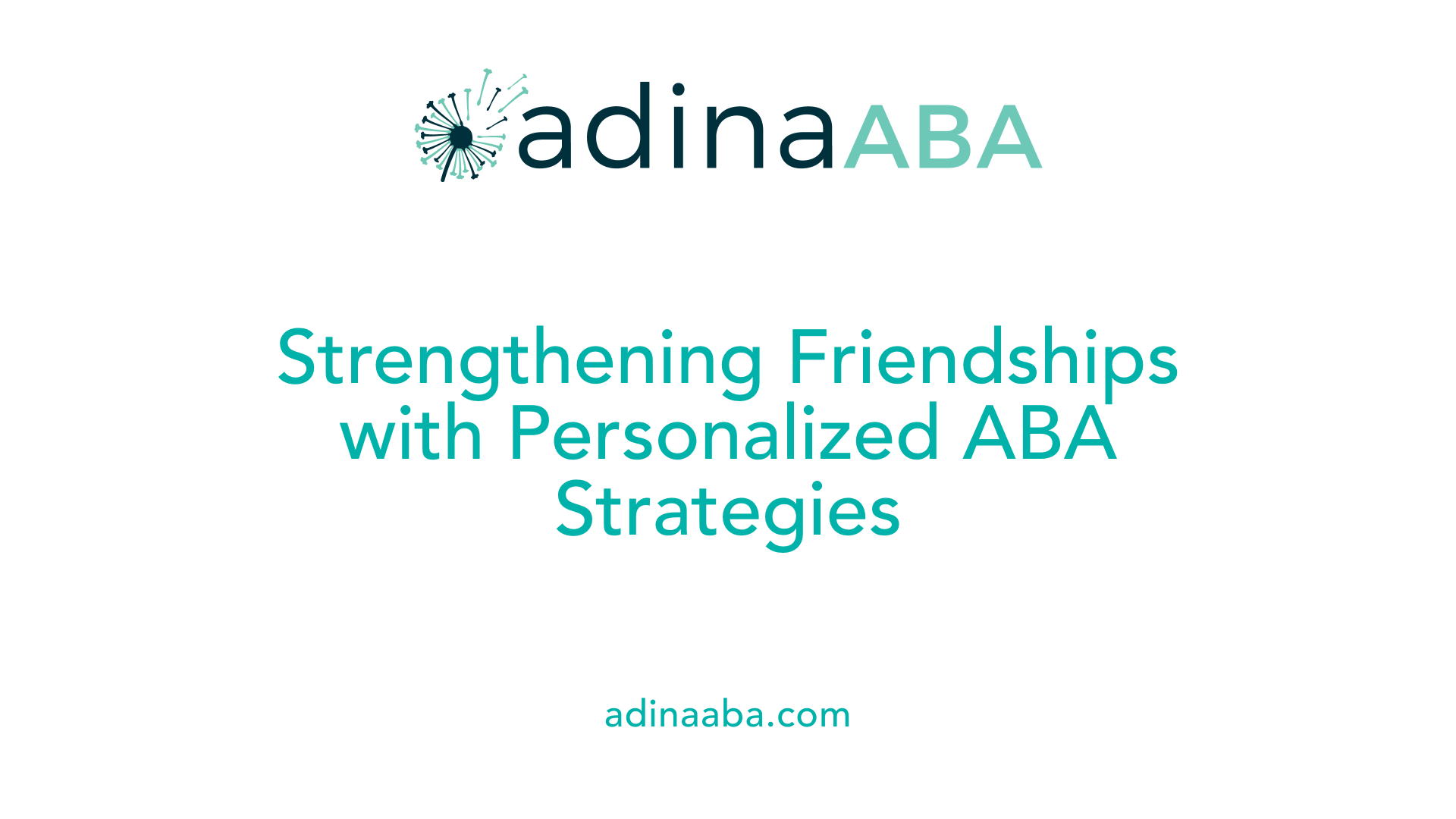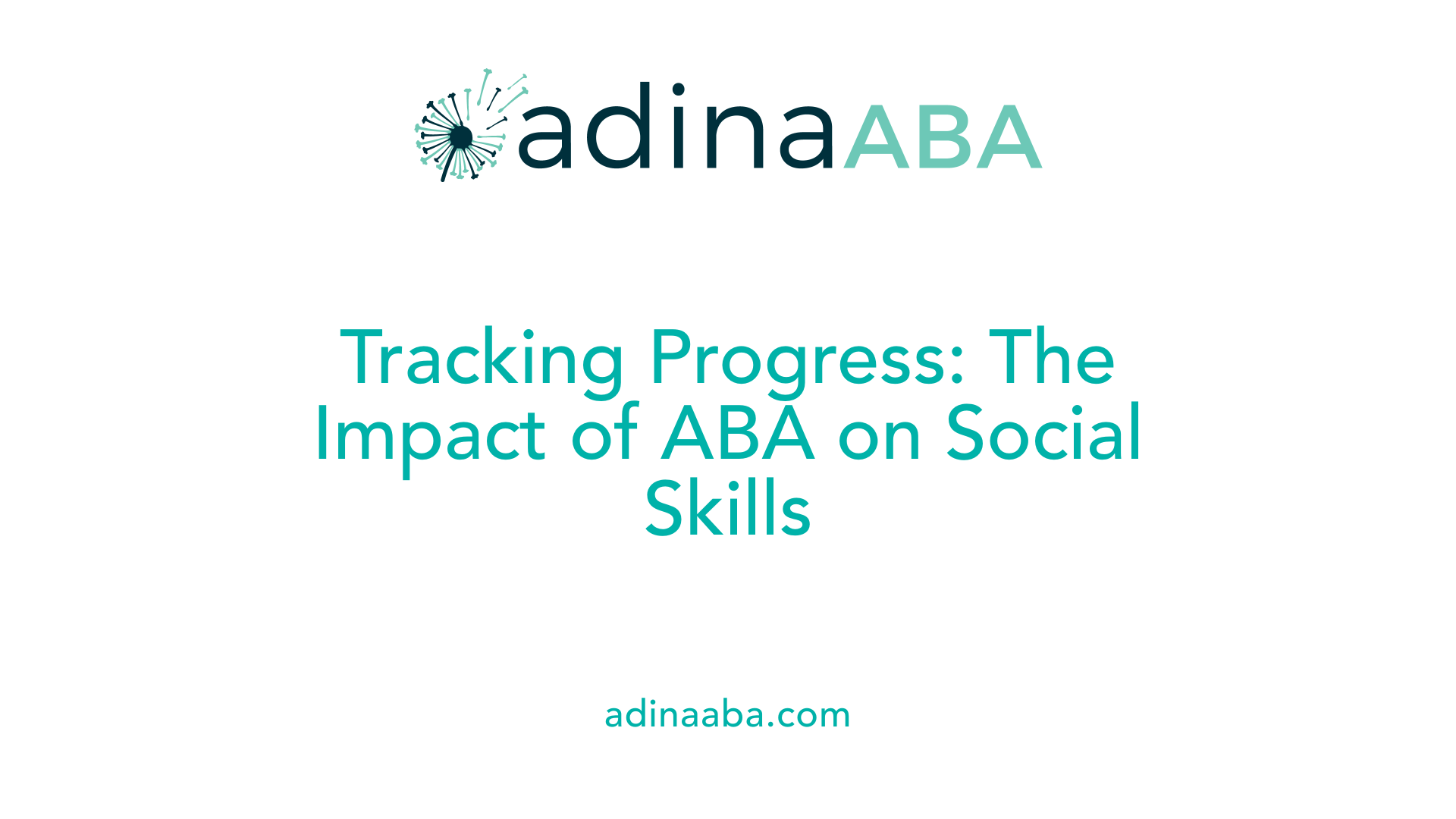How ABA Therapy Helps Children with Autism Build Stronger Peer Relationships

Understanding the Power of ABA in Social Development for Autism
Applied Behavior Analysis (ABA) is a scientifically supported intervention that plays a vital role in enhancing social skills among children with autism. Its structured, individualized approach targets key social behaviors, promoting better peer relationships and overall social participation. This article explores how ABA techniques foster communication, cooperation, and confidence, enabling children with autism to forge meaningful connections with their peers.
Core Principles and Techniques of ABA in Social Skills Development

What are Discrete Trial Training (DTT) and Pivotal Response Training (PRT)?
Discrete Trial Training (DTT) and Pivotal Response Training (PRT) are structured ABA techniques designed to teach social and communication skills in children with autism. DTT breaks down complex behaviors into small, manageable steps and uses repeated trials to reinforce learning. It often involves clear prompts, specific responses, and immediate positive reinforcement to encourage correct behavior.
PRT focuses on pivotal areas such as motivation, response to multiple cues, and self-management. It fosters spontaneous social behaviors by emphasizing children's interests and natural environments, making learning more engaging.
These methods are tailored to each child's needs, maximizing skill acquisition in social settings.
How does positive reinforcement support social skills?
Positive reinforcement is central to ABA therapy. It involves rewarding desirable behaviors like eye contact, sharing, or initiating conversations with preferred stimuli or praise. This technique encourages children to repeat these behaviors, gradually building their social interaction skills.
For example, a child might receive a compliment or a favorite toy for successfully greeting a peer or making eye contact. Reinforcing these actions increases the likelihood of them occurring in different settings, including school, home, and community.
What role do modeling and role-playing play in promoting social behavior?
Modeling and role-playing are effective ways to teach social norms. Therapists or parents demonstrate specific behaviors, such as taking turns or responding to questions. Children observe these models and practice through role-play, gaining confidence and understanding.
Practicing scenarios like introducing oneself, saying hello, or asking for help helps children generalize the skills across various situations, promoting meaningful peer interactions.
How do social stories and visual supports enhance social understanding?
Social stories are simple, visual narratives that explain social cues, routines, and expected behaviors. They help children anticipate social interactions and understand what is appropriate.
Visual supports like picture cards or schedules clarify complex social concepts and make abstract ideas concrete. They serve as visual prompts during social situations, helping children regulate their responses and participate more actively.
What are the long-term benefits of early ABA intervention for social skills?
Intervening early with ABA can significantly improve social outcomes. Children typically develop better communication, emotional regulation, and peer relationship skills.
Structured ABA approaches break down social behaviors into small steps, reinforcing successes and gradually increasing social independence.
Scientific research shows that early and intensive ABA therapy leads to less severe social deficits, better academic performance, and increased chances of community integration as children grow.
How are ABA techniques adapted to individual needs?
ABA programs are continuously personalized based on ongoing assessments. Therapists observe each child's strengths, challenges, and interests, then modify strategies accordingly.
This adaptable approach ensures that interventions are relevant and motivating, which promotes consistent progress.
How does data collection support social skills development?
Regular data collection helps track each child's response to interventions, guiding therapists in adjusting strategies. It provides objective measures of progress, ensuring that goals are being met and interventions remain effective.
Which practical activities help children practice social skills?
Structured group activities like art classes, music groups, or team sports provide real-life practice. These environments teach cooperation, sharing, and turn-taking.
Engaging in collaborative projects or group games during therapy sessions also enhances social competence and confidence.
| Technique | Description | Outcome |
|---|---|---|
| Discrete Trial Training (DTT) | Breaking tasks into small, repeated trials | Skill mastery and reinforcement |
| Pivotal Response Training (PRT) | Focus on motivation and natural scenarios | Spontaneous social behaviors |
| Positive Reinforcement | Rewards for desired behaviors | Increased social engagement |
| Modeling & Role-playing | Demonstrating and practicing behaviors | Confidence in social settings |
| Social Stories & Visual Supports | Visual narratives and cues | Better understanding of social cues |
What is the overall impact of ABA on social development?
ABA therapy fosters independence, improves communication, and reduces problematic behaviors. It lays a strong foundation for children to navigate social environments confidently.
By promoting social skills and emotional understanding, ABA helps children build meaningful peer relationships and participate fully in their communities.
Tailored Strategies for Fostering Peer Interactions
What techniques and strategies are used in ABA therapy to foster peer relationships?
ABA therapy utilizes a range of personalized techniques aimed at improving peer interactions for children with autism. Central to these methods are social skills training sessions where children learn basic interaction cues such as making eye contact, initiating greetings, and taking turns.
Role-playing and peer modeling provide real-life practice opportunities, helping children understand social norms through guided interactions. Visual supports, including social stories and visual schedules, serve as effective tools for teaching social cues, appropriate responses, and expected behaviors in different social scenarios.
Positive reinforcement plays a crucial role; when a child successfully shares, initiates conversation, or demonstrates other social behaviors, they receive praise or preferred activities as rewards. This pairing of enjoyable outcomes with social behaviors increases motivation and encourages continued practice.
Structured activities like group games, collaborative projects, and community outings create natural environments for children to apply their social skills. These settings promote comfort and reduce anxiety, resulting in more confident peer engagement.
ABA therapists frequently work closely with caregivers and educators to ensure that social skills learned during therapy are reinforced across different environments. Consistent opportunities for practice help children generalize their skills beyond the therapy setting, leading to better integration with peers.
Moreover, developing communication skills, including understanding non-verbal cues and responding appropriately, enhances social compatibility. Tailoring interventions to the child's specific strengths and challenges ensures that the strategies are effective and adaptable as they progress.
In summary, by combining social skills training, visual supports, positive reinforcement, and collaborative practice, ABA therapy creates a comprehensive approach to strengthening peer relationships for children with autism.
The Role of Structured Group Activities in Social Development

How do structured group activities and group therapy contribute to social skill development in children with autism?
Structured group activities and group therapy are essential in helping children with autism develop crucial social skills. These activities create a safe and supportive environment where children can practice interaction techniques like turn-taking, initiating conversations, and interpreting social cues.
During group sessions, children engage in activities such as group games, collaborative projects, and social scenarios designed to mirror everyday interactions. These experiences allow children to apply skills in a real-world context while receiving guidance from trained therapists.
One of the most effective strategies used in group settings includes role-playing, where children practice social behaviors and receive feedback. Social stories and peer modeling are also employed to teach appropriate responses and social norms.
Participation helps children build confidence as they successfully navigate social situations and foster peer relationships. Moreover, these activities promote emotional growth, resilience, and a sense of belonging.
In addition, real-life scenarios like cooperative tasks and group problem-solving activities replicate typical social interactions outside of therapy. This exposure enhances generalization of skills to settings like school, home, and community.
Research, including insights from the Association for Behavior Analysis International, highlights that consistent participation in structured group activities can significantly improve social functioning in children with autism.
| Benefits of Group Activities | Examples | How They Support Social Development |
|---|---|---|
| Practice social norms | Greetings, eye contact | Reinforces appropriate social behaviors |
| Enhance communication skills | Group conversations, sharing | Builds verbal and non-verbal skills |
| Foster peer relationships | Collaborative projects, games | Promotes cooperation and friendship |
| Build confidence | Success in activities | Encourages participation and emotional resilience |
Through these structured experiences, children learn not only social skills but also gain confidence and independence, preparing them for more complex social environments.
Building Stronger Peer Relationships Through Personalized ABA Support

How does ABA therapy support children with autism in building stronger peer relationships?
ABA therapy plays a vital role in helping children with autism develop better peer relationships. It begins by explicitly teaching essential social skills such as making eye contact, initiating conversations, taking turns, and sharing. Therapists break down these complex behaviors into small, manageable steps and reinforce each success using positive reinforcement, which encourages children to practice and improve.
Creating structured social opportunities is another core component of ABA. These include organized playdates, social skills groups, and group activities like puzzles or collaborative projects. Such settings provide safe environments for children to practice their newly learned skills, gain confidence, and learn appropriate social behaviors.
Encouraging children to engage with their interests alongside peers strengthens connections. For example, a child interested in art might participate in craft sessions with others, fostering shared experiences.
Modeling positive social behaviors, such as polite greetings, body language, and respectful interactions, helps children learn what appropriate behavior looks like in social contexts. Therapists and family members serve as role models, demonstrating how to interact positively.
Furthermore, ABA supports the development of empathy and perspective-taking. Through social stories, role-playing, and guided discussions, children learn to understand others’ feelings and viewpoints, which is crucial for building genuine friendships.
Overall, ABA’s personalized approach combines skill teaching, reinforcing positive interactions, and involving families in practice, ultimately strengthening children’s ability to form and maintain meaningful peer relationships.
Measuring Success: Outcomes of ABA in Social Functioning

How is social progress assessed in ABA therapy?
In ABA therapy, progress is closely monitored through detailed behavioral data collection. Therapists observe and record specific social behaviors such as eye contact, joint attention, and reciprocity during sessions. This systematic tracking helps determine whether children are improving and which strategies are most effective. Regular assessments guide goal adjustments to ensure ongoing development.
How are goals set and reviewed?
Goals in ABA are individualized, based on comprehensive assessments of each child's strengths and needs. Therapists and parents collaborate to define clear, measurable targets like initiating conversations or responding to questions appropriately. Progress is reviewed frequently through data analysis, allowing for timely modifications to intervention plans.
Which social skills improve with ABA?
Children typically show marked improvements in essential social skills, including maintaining eye contact, engaging in reciprocal interactions, and understanding non-verbal cues. They learn to respond to questions, take turns during conversations, and initiate social exchanges, which are vital for building peer relationships.
What are the long-term benefits of ABA?
The long-term advantages include better social integration, increased independence, and improved academic and daily living skills. Children gain confidence to participate in group activities and community events, reducing social isolation. These outcomes contribute to more successful transitions into adolescence and adulthood.
| Social Skill Area | Expected Outcomes | Description |
|---|---|---|
| Eye Contact | Increased frequency | Encourages engagement and attention during interactions |
| Joint Attention | Better sharing focus | Allows children to follow another's gaze or point, essential for learning |
| Reciprocity | Improved back-and-forth communication | Facilitates meaningful social exchanges |
| Initiating Conversation | More spontaneous talking | Builds peer relationships and social independence |
| Responding to Social Questions | Appropriate responses | Enhances understanding of social norms |
| Conflict Resolution | Using calming and respectful strategies | Strengthens peer relationships and emotional regulation |
| Daily Living Skills | Greater independence | Teaches routines like dressing and hygiene to foster autonomy |
Research by organizations such as the Association for Behavior Analysis International confirms that ABA therapy significantly improves social interactions. Children develop better peer relationships, participate more in social activities, and demonstrate enhanced social understanding. These positive changes support their integration into broader social environments and lay a foundation for long-term success.
Enhancing Independence and Confidence Through ABA
How do structured group activities and group therapy contribute to social skill development in children with autism?
Structured group activities and therapy sessions are integral ways to help children with autism improve their social abilities. These environments provide safe spaces where children can practice essential social behaviors such as taking turns, initiating conversations, and understanding social cues.
In group settings, children participate in activities like role-playing, social stories, and peer modeling, guided by experienced professionals. These techniques enable children to observe and imitate positive behaviors, gain confidence, and learn how to navigate social interactions more effectively.
Parental involvement and continued participation reinforce skills learned during therapy, helping children generalize these behaviors to everyday settings like school and community activities. Over time, children become more comfortable engaging with peers, which boosts their emotional and social development.
While the immediate effects may be modest, consistent practice in group environments combined with tailored feedback allows children to build skills steadily. These structured social experiences are crucial components of comprehensive support strategies aimed at fostering independence and self-confidence.
| Activity Type | Goals Achieved | Examples |
|---|---|---|
| Role-playing | Practice social responses and conversational skills | Peer interactions, greetings |
| Peer modeling | Demonstrate appropriate behaviors in social contexts | Sharing, cooperating |
| Feedback sessions | Reinforce desired behaviors and correct mistakes | Reinforcing eye contact, turn-taking |
| Creative group tasks | Enhance teamwork and communication skills | Artistic projects, group puzzles |
How does ABA therapy support developing skills for independent daily living?
ABA therapy is highly effective in teaching children vital daily activities, from brushing teeth to tying shoelaces. Therapists break these tasks into manageable steps, providing visual aids and consistent reinforcement for each successfully completed task.
This structured approach helps children gain confidence and reduces frustration by making complex activities seem achievable. As children master these skills, they become more self-reliant, which contributes to their overall independence.
In addition to practical skills, ABA also focuses on emotional regulation and problem-solving strategies, enabling children to manage their feelings and respond appropriately to various situations. These combined skills are essential for reducing behavioral issues like tantrums and aggression.
Therapists continuously assess progress and modify goals and techniques to ensure each child's unique needs are met, promoting growth in both independence and emotional well-being.
By fostering self-reliance in daily routines, ABA therapy lays a strong foundation for children to thrive socially and emotionally into adolescence and adulthood, ultimately supporting a more independent life.
Empowering Youth: The Long-Term Impact of ABA on Social Skills
In conclusion, ABA therapy is a comprehensive, evidence-based approach that significantly enhances social skills for children with autism. Through tailored techniques like social stories, peer modeling, and positive reinforcement, children learn to navigate social norms, communicate effectively, and build lasting peer relationships. Structured group activities and family involvement further reinforce these skills across various environments, fostering confidence and independence. As research confirms the long-term benefits of early, intensive intervention, ABA remains a cornerstone for fostering social inclusion and success for children with autism. By enabling children to participate more fully in their communities, ABA paves the way for brighter social futures and greater quality of life.
References
- Understanding ABA ASD: Key Benefits for Autism Treatment
- How ABA Therapy Helps Improve Social Skills in Children
- Building Peer Connections: Autism Group Activities
- Benefits of ABA Therapy for Children with Autism
- The Top 10 Reasons Children With Autism Deserve ABA - PMC
- 6 Life-Changing Benefits of ABA Therapy for Children with Autism
- How ABA Therapy Helps With Social Skills
- 10 Benefits of ABA Therapy for Autism in the Coachella Valley
More Resources
Expert Clinicians
Get started today ->



.jpg)


.jpg)